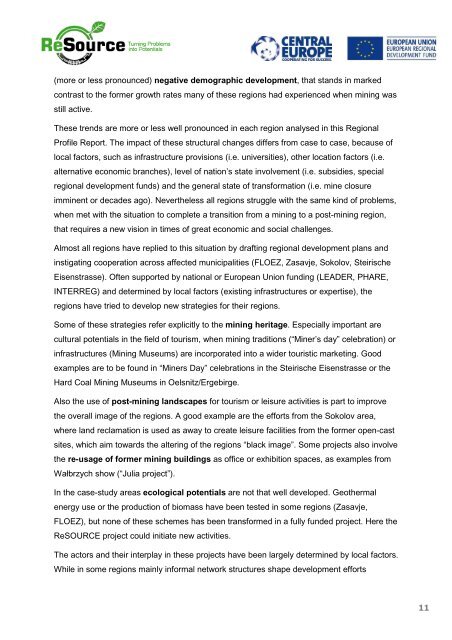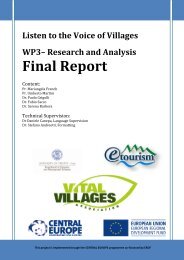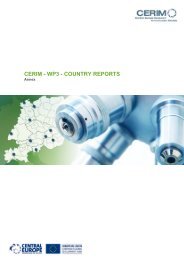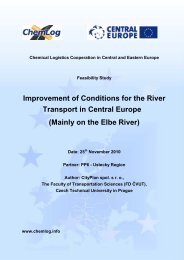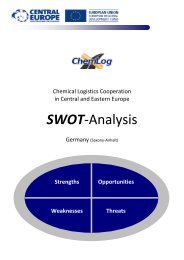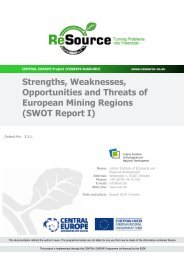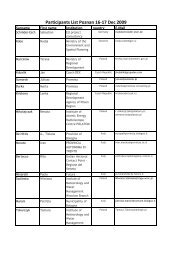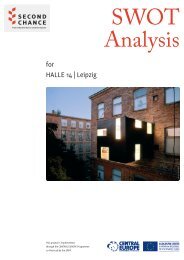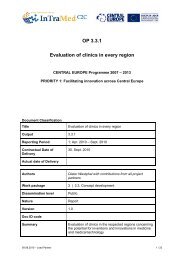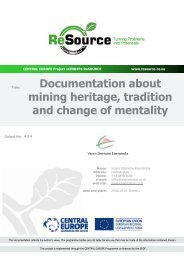Title: Regional Profile Report - Central Europe
Title: Regional Profile Report - Central Europe
Title: Regional Profile Report - Central Europe
Create successful ePaper yourself
Turn your PDF publications into a flip-book with our unique Google optimized e-Paper software.
(more or less pronounced) negative demographic development, that stands in marked<br />
contrast to the former growth rates many of these regions had experienced when mining was<br />
still active.<br />
These trends are more or less well pronounced in each region analysed in this <strong>Regional</strong><br />
<strong>Profile</strong> <strong>Report</strong>. The impact of these structural changes differs from case to case, because of<br />
local factors, such as infrastructure provisions (i.e. universities), other location factors (i.e.<br />
alternative economic branches), level of nation’s state involvement (i.e. subsidies, special<br />
regional development funds) and the general state of transformation (i.e. mine closure<br />
imminent or decades ago). Nevertheless all regions struggle with the same kind of problems,<br />
when met with the situation to complete a transition from a mining to a post-mining region,<br />
that requires a new vision in times of great economic and social challenges.<br />
Almost all regions have replied to this situation by drafting regional development plans and<br />
instigating cooperation across affected municipalities (FLOEZ, Zasavje, Sokolov, Steirische<br />
Eisenstrasse). Often supported by national or <strong>Europe</strong>an Union funding (LEADER, PHARE,<br />
INTERREG) and determined by local factors (existing infrastructures or expertise), the<br />
regions have tried to develop new strategies for their regions.<br />
Some of these strategies refer explicitly to the mining heritage. Especially important are<br />
cultural potentials in the field of tourism, when mining traditions (“Miner’s day” celebration) or<br />
infrastructures (Mining Museums) are incorporated into a wider touristic marketing. Good<br />
examples are to be found in “Miners Day” celebrations in the Steirische Eisenstrasse or the<br />
Hard Coal Mining Museums in Oelsnitz/Ergebirge.<br />
Also the use of post-mining landscapes for tourism or leisure activities is part to improve<br />
the overall image of the regions. A good example are the efforts from the Sokolov area,<br />
where land reclamation is used as away to create leisure facilities from the former open-cast<br />
sites, which aim towards the altering of the regions “black image”. Some projects also involve<br />
the re-usage of former mining buildings as office or exhibition spaces, as examples from<br />
Wałbrzych show (“Julia project”).<br />
In the case-study areas ecological potentials are not that well developed. Geothermal<br />
energy use or the production of biomass have been tested in some regions (Zasavje,<br />
FLOEZ), but none of these schemes has been transformed in a fully funded project. Here the<br />
ReSOURCE project could initiate new activities.<br />
The actors and their interplay in these projects have been largely determined by local factors.<br />
While in some regions mainly informal network structures shape development efforts<br />
11


